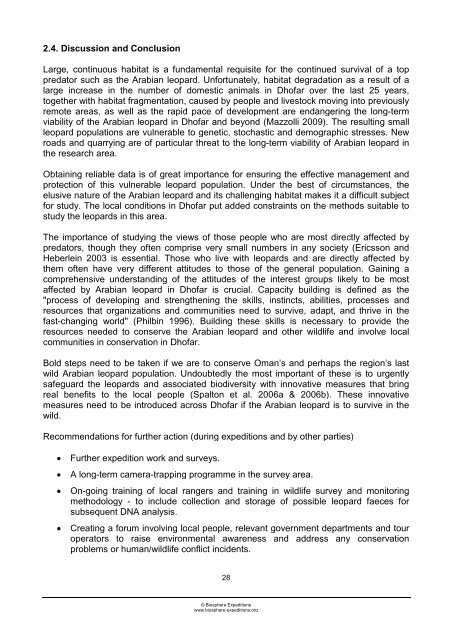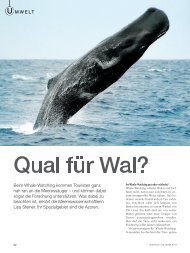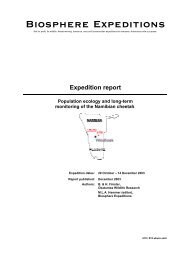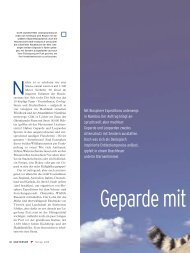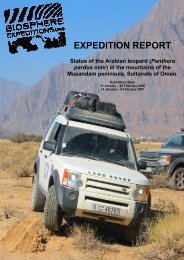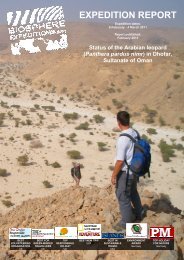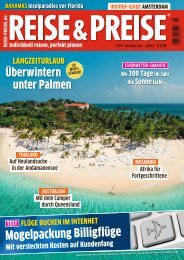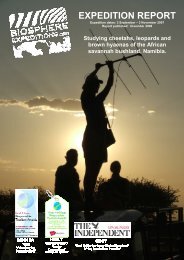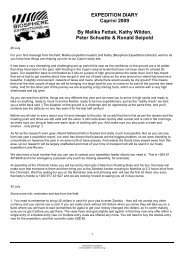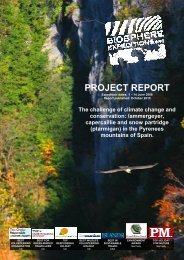EXPEDITION REPORT - Biosphere Expeditions
EXPEDITION REPORT - Biosphere Expeditions
EXPEDITION REPORT - Biosphere Expeditions
You also want an ePaper? Increase the reach of your titles
YUMPU automatically turns print PDFs into web optimized ePapers that Google loves.
2.4. Discussion and Conclusion<br />
Large, continuous habitat is a fundamental requisite for the continued survival of a top<br />
predator such as the Arabian leopard. Unfortunately, habitat degradation as a result of a<br />
large increase in the number of domestic animals in Dhofar over the last 25 years,<br />
together with habitat fragmentation, caused by people and livestock moving into previously<br />
remote areas, as well as the rapid pace of development are endangering the long-term<br />
viability of the Arabian leopard in Dhofar and beyond (Mazzolli 2009). The resulting small<br />
leopard populations are vulnerable to genetic, stochastic and demographic stresses. New<br />
roads and quarrying are of particular threat to the long-term viability of Arabian leopard in<br />
the research area.<br />
Obtaining reliable data is of great importance for ensuring the effective management and<br />
protection of this vulnerable leopard population. Under the best of circumstances, the<br />
elusive nature of the Arabian leopard and its challenging habitat makes it a difficult subject<br />
for study. The local conditions in Dhofar put added constraints on the methods suitable to<br />
study the leopards in this area.<br />
The importance of studying the views of those people who are most directly affected by<br />
predators, though they often comprise very small numbers in any society (Ericsson and<br />
Heberlein 2003 is essential. Those who live with leopards and are directly affected by<br />
them often have very different attitudes to those of the general population. Gaining a<br />
comprehensive understanding of the attitudes of the interest groups likely to be most<br />
affected by Arabian leopard in Dhofar is crucial. Capacity building is defined as the<br />
"process of developing and strengthening the skills, instincts, abilities, processes and<br />
resources that organizations and communities need to survive, adapt, and thrive in the<br />
fast-changing world" (Philbin 1996). Building these skills is necessary to provide the<br />
resources needed to conserve the Arabian leopard and other wildlife and involve local<br />
communities in conservation in Dhofar.<br />
Bold steps need to be taken if we are to conserve Oman’s and perhaps the region’s last<br />
wild Arabian leopard population. Undoubtedly the most important of these is to urgently<br />
safeguard the leopards and associated biodiversity with innovative measures that bring<br />
real benefits to the local people (Spalton et al. 2006a & 2006b). These innovative<br />
measures need to be introduced across Dhofar if the Arabian leopard is to survive in the<br />
wild.<br />
Recommendations for further action (during expeditions and by other parties)<br />
� Further expedition work and surveys.<br />
� A long-term camera-trapping programme in the survey area.<br />
� On-going training of local rangers and training in wildlife survey and monitoring<br />
methodology - to include collection and storage of possible leopard faeces for<br />
subsequent DNA analysis.<br />
� Creating a forum involving local people, relevant government departments and tour<br />
operators to raise environmental awareness and address any conservation<br />
problems or human/wildlife conflict incidents.<br />
28<br />
© <strong>Biosphere</strong> <strong>Expeditions</strong><br />
www.biosphere-expeditions.org


